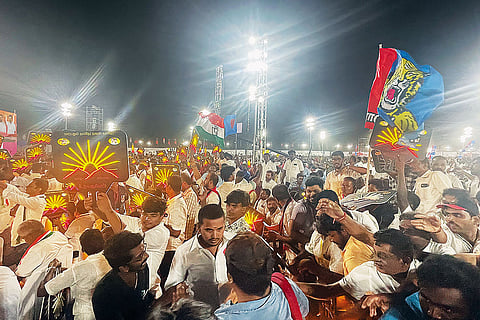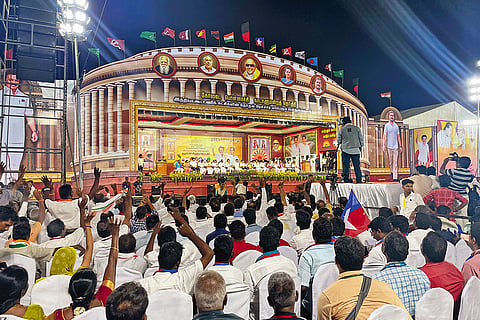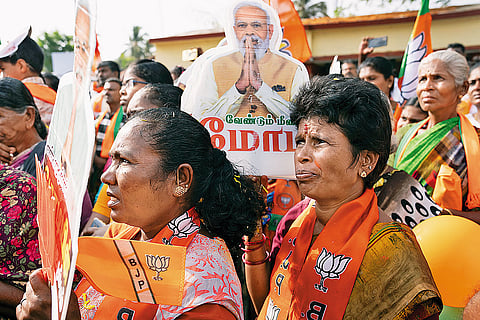Prime Minister Narendra Modi has made seven visits to Tamil Nadu in the last forty days, trying hard to woo Tamilians with every trick in the book. He’s spoken about his love for the Tamil language, his love for dosas, his love for this ancient civilisation. One of his roadshows in Coimbatore was conducted in the same Hindu locality where the 1998 bomb blasts happened—a lame duck bid to revive the communal polarisation that tore through the city.
Tamil Nadu: Deep Moats Of The Dravidian Citadel
Will the BJP’s desperate efforts to splinter the people along caste, religious, regional and linguistic fault lines bear fruit in Tamil Nadu’s western districts?
The national and international media attention and speculation on Coimbatore has been bizarre and cloying—the ad nauseam belief that Western Tamil Nadu (the Kongu belt) would find itself electing a BJP candidate contesting over two Dravidian opponents is jarring. Those who know the history of Tamil Nadu would know that the man who reshaped this state’s trajectory, Thanthai Periyar, was born in Erode, the same region where the BJP is fantasising about its victory.
***
A life-size statue of Periyar stands in front of the Gandhipuram office of the Thanthai Periyar Dravidar Kazhagam, an organisation committed to propagating his views of social justice, rationalism and feminism. “The idea of Kongunadu is itself associated with a caste identity,” says Kovai Ramakrishnan, the founder-leader of this Periyarist organisation. He explains, “No other group except the Kongu Vellala Gounders (KVG) lay claim to this specific regional identity. The BJP thinks that it has some potential to try and win them over. They may not have much traction among the people, but the upper crust of this community might be attracted to them out of sheer opportunism.”

Flush with new money, having branched off from being feudal landlords into establishing themselves as businessmen and industrialists, the next logical step for the KVGs has been geared towards political power and authority. For these aspirational rich men—unable to compete with the existing KVGs in the Dravidian parties, self-aware that it would take long to climb those worn-out ladders—the BJP offered a shortcut. A new opening, a growth opportunity.
Secondly, the unshakeable belief that being allied to the ruling party would protect their monetary interests, and have their back were industrial or caste disputes to arise, also drives the big businessmen into the arms of the BJP.
After we have finished taking soundbites from its founder-leader Kovai Ramakrishnan, I watch two young men in their 20s come to him and recount what happened earlier that day. “We were distributing the leaflets and vadai, telling them, here, take the Modi-vadai, and it was going well, but then the police came. They asked us to stop distribution, they took our names.” He tells them to carry on with other activities and not be perturbed by this encounter with the police. Vadai sudradhu (making vada), a Tamil metaphor for an elaborate embellished lie, has now become inextricably linked with Modi—and the Modi vadai is a stock meme and campaign material.
***
Not all young people are as dismissive of the Modi phenomenon as the two young vadai-distributing Periyarist men.
At the bustling Cross Cut Road intersection, we run into a group of young women who are being herded from vans to the Nirmala Sitharaman roadshow. When asked who they will vote for, the young women laugh nervously. Pressed further, a girl points to her friend and says, “She likes Annamalai.” Why? “It is her daddy’s name.” Support for the BJP here is ascribed to the most random reasons.

Arumugam, the managing director of a famous silk sari store, says his vote is for the BJP. “It is not Annamalai, it is a vote for Modi.” The reason: “He’s abolished black money. He’s against corruption.” Then, Arumugam reels off some information about Rahul Gandhi resigning from his post that morning. Clearly, there are many adherents of WhatsApp university, and Tamil uncles lead in this sector. Younger people, whose chief source of information is Instagram reels and Twitter brawls, come in a close second. Here, social media propaganda has allowed Annamalai to garner outsize support.
Explaining why first-time and young voters in the region are drawn towards the BJP, celebrated Tamil author Perumal Murugan points out that they’ve moved into a space left bereft by the declining presence of actor fan clubs. The BJP has managed to capitalise on the restless energy of the youth, while craftily presenting themselves as the “fresh face” and “alternative” to the two Dravidian parties.
They’ve spent massively in these areas, opening party offices all over the place and offering youngsters the backing to contest the local body elections. He believes that the BJP has copied verbatim the Communist formula of politicisation of students in the Left tradition through organising meetings, workshops, and sports events, besides helping with paying fees or finding accommodation. The added features by their student wing, the ABVP, include taking them away on 3-4 day trips, making the students stay in star hotels, and sponsoring these activities. Such a multilateral approach by the BJP is strategically aimed at cultivating youngsters as a vote bank. “Parents also tacitly support these activities; they are happy that the young people are being channelised,” he adds.
***

The bait-and-trap mechanism of the BJP would appear seemingly jejune: after all, which political party would shy away from massive recruitment? Days later, chatting with Mahesh, a 42-year-old self-made entrepreneur in Palladam, whose garment business has dwindled from offering employment to 150 people to a mere 25, we learn of the caste-specific dangers of the BJP project. He lists out the economic policies of the 10 BJP years which have proved catastrophic to MSMEs like his: demonetisation, the arbitrary GST regime, the 45-day policy for settlement of dues, opening the domestic market to cheap imports from Bangladesh, and the concerted efforts to force a shutdown of the textile industry in Tamil Nadu with a view of moving it to Gujarat.
This is a constant refrain we encounter and mirrors the mood on the ground—MSMEs in Palladam and Sulur, coming within the Coimbatore parliamentary constituency, have been badly hit by the central government’s policies. Mahesh is equally keen to share his opinion on the BJP’s social engineering. “Community-wise division is more important to the BJP than any one community; they can only thrive on divide-and-rule.”
“They seek to import the Dharmapuri Model into the Kongu region,” Mahesh says. In 2012, when Divya (from the dominant Vanniyar caste) fell in love with and married Ilavarasan, a Dalit youth in Dharmapuri, Vanniyar mobs led by the PMK (Pattali Makkal Katchi, an alliance partner of the BJP) burnt the homes of more than 300 Dalit families to impart a “lesson”.

Later, Ilavarasan’s body was found on the railway tracks—it is widely believed that it was a murder dressed up as a suicide. The PMK launched its propaganda about “nadaga kadhal”—the caste equivalent of the fear-mongering idea behind “love jihad”—saying that Dalit men were involved in staged love, and that they sought to entice and cheat dominant caste Hindu women. In the dozen years that have followed, this canard has provided the perfect opportunity to hunt down and harass Dalit men and to enforce social vigilantism in dominant castes across the state. This vile propaganda did not remain tied down to northern Tamil Nadu.
Last year, the Madras High Court upheld the conviction of S Yuvaraj of the Theeran Chinnamalai Gounder Peravai (a KVG outfit named after a freedom fighter from the community) who was awarded a life sentence along with eight others for the 2015 murder of V Gokulraj, a Dalit engineer, for allegedly being in love with a Hindu girl. The poison of caste had started claiming lives in the Kongu belt as well. The Valli Kummi dance, a central motif of the KVG identity in this region, has now started to be used by caste-based political outfits as a conformist propaganda tool.
Earlier this year, videos of young women of the KVG caste being forced to pledge to their clan god Murugan that they will only marry men from their caste went viral. Caste cannot ensure gatekeeping without inherent patriarchal control—identity quickly morphs into the question of saving women’s honour.

In addition to this reinforcement of caste identity, Mahesh reveals that the activity-oriented approach of the BJP-RSS combine is aimed at long-term recruitment. “The kind of group mobilisation of teenagers that happens around Vinayaka Chaturthi is hugely problematic. Parents willingly send their kids, thinking this is about god and religion,” he says. Dalits, who form nearly a quarter of the voting population in this constituency, are wary of what aggressive Hindutva would mean to their lives. An Arundhatiyar activist, associated with the CPM’s student wing SFI from his teenage years, says that the BJP coming to power for the third time would mean the death knell for mobility through education. “Their New Education Policy is actually the kulakalvi scheme—they are trying to make the people take up their hereditary occupation right after the fifth standard. It will undo all the work that has been done,” says Mahesh.
The ideology of the Dravidian Movement has not just been the mere espousal of secularism but an aggressive social welfare model which has seen dividends over the last six decades. For communities like the Arundhatiyars—for whom the Kalaignar Karunanidhi-led government offered sub-reservation within the Dalit category—the arrival of the BJP heralds a downward slide in their upward mobility and social advancement.
***
The larger question remains: Will the BJP’s desperate efforts to splinter the people along caste, religious, regional and linguistic fault lines bear fruit in Tamil Nadu’s western districts?
Rajkumar Ganapathy, the DMK’s Coimbatore candidate, is certain that the BJP will be totally routed. “We are a peace-loving people,” he says, pointing out that the BJP’s roadshows in Mettupalayam (with a sizeable Muslim population) and Coimbatore were not successful. Alluding to the hype around BJP candidate Annamalai, Rajkumar says, “It is mainly because of social media. Not practically, not the reality and not on the ground. They don’t have the party structure. They are very noisy on social media, that’s it.”
In another six weeks, we will decisively know if the Dravidian Fortress has remained impregnable.
He calls out the north-Indian media for basing their assumptions on social media traffic, clarifying that the opposite is the ground reality. “Their aggression will simply not work here. Hindutva is not suited for Tamil Nadu because Hindutva is nothing but divide and rule.”
Rajkumar is an interesting case study—he was elected as Coimbatore’s mayor in 2014, and most interestingly, on an AIADMK ticket. His PhD thesis, he tells us, was on the emergence of Jayalalithaa as a mass leader. After her death, he crossed over to the DMK.
Singai G Ramachandran, a 36-year-old IIM-A graduate, is running on the AIADMK ticket. He is the perfect antithesis to Annamalai—where Annamalai is aggressive, Ramachandran speaks in a composed, balanced manner; where Annamalai boasts about his qualifications and credentials, Ramachandran plays them down. He calls out the BJP for their empty balance sheet where Tamil Nadu is concerned and says they’re using the communal card because they’ve nothing to show as achievements. He downplays Annamalai’s aggression and personal attacks as a symptom of anxiety.
At a late evening road show, actress Vindhya, campaigning for the AIADMK candidate Singai Ramachandran vociferously condemns the BJP for trying to rake up the memory of the 1998 bomb blasts. Addressing a large crowd predominantly made up of women—sari-clad Hindu women with their plates of flower petals and Muslim women in hijab—she labels the BJP an evil force intent on dividing the people.
“Remember that the person who raises the goat is also the one who offers it for sacrifice on a holy day,” she says to loud cheers. “This is the established custom in this land. This goat will also have a similar fate.” Across the political divide, and barring the BJP, aadu (goat in Tamil) has become a political shorthand to refer to Annamalai, who famously posed with kid goats and vowed to take up farming after resigning from the IPS. When DMK Minister TRB Raaja arrived in Coimbatore to oversee the party’s campaign, he was gifted with a goat. Tamil meme-makers have flooded the internet with jibes about “mutton biryani” waiting to be served on June 4, when the results are announced, an obvious reference to Annamalai’s anticipated defeat.
While the DMK and the AIADMK leadership and grassroots cadre consistently make it clear that this is a contest between the two Dravidian giants, the BJP that has made little inroads on the ground survives on the oxygen of propaganda. Several major news outlets, national and international, have descended in Coimbatore to study and unpack the Annamalai phenomenon. He remains a phantom politician who routinely spews lies and insults his opponents, a Frankenstein’s monster created by the BJP’s bot armies and pliant media outlets, ballooned into prominence by endless replication. It is a bubble waiting to be burst.
In another six weeks, we will decisively know if the Dravidian Fortress has remained impregnable. If the Dravidian parties manage to hold the fort and ensure that the BJP draws a blank in these elections, it would also prove to be a classic case study for North Indian media not to be carried away by social media hype and targeted PR operations.
Meena Kandasamy is a writer and a poet based in Chennai